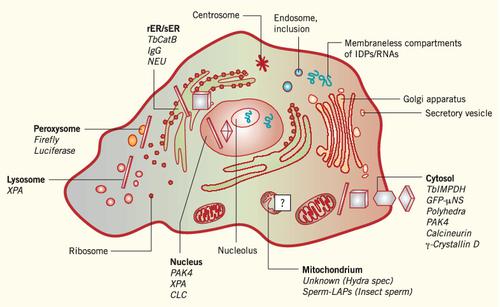Our official English website, www.x-mol.net, welcomes your feedback! (Note: you will need to create a separate account there.)
Protein phase separation and determinants of in cell crystallization.
Traffic ( IF 4.5 ) Pub Date : 2019-10-30 , DOI: 10.1111/tra.12711 Celestin N Mudogo 1, 2 , Sven Falke 1 , Hévila Brognaro 1, 3 , Michael Duszenko 4 , Christian Betzel 1
Traffic ( IF 4.5 ) Pub Date : 2019-10-30 , DOI: 10.1111/tra.12711 Celestin N Mudogo 1, 2 , Sven Falke 1 , Hévila Brognaro 1, 3 , Michael Duszenko 4 , Christian Betzel 1
Affiliation

|
Liquid-liquid phase separation (LLPS) in cells is known as a complex physicochemical process causing the formation of membrane-less organelles (MLOs). Cells have well-defined different membrane-surrounded organelles like mitochondria, endoplasmic reticulum, lysosomes, peroxisomes, etc., however, on demand they can create MLOs as stress granules, nucleoli and P bodies to cover vital functions and regulatory activities. However, the mechanism of intracellular molecule assembly into functional compartments within a living cell remains till now not fully understood. in vitro and in vivo investigations unveiled that MLOs emerge after preceding liquid-liquid, liquid-gel, liquid-semi-crystalline, or liquid-crystalline phase separations. Liquid-liquid and liquid-gel MLOs form the majority of cellular phase separation events, while the occurrence of micro-sized crystals in cells was only rarely observed, however can be considered as a result of a preceding protein phase separation event. In vivo, also known and termed as in cellulo crystals, are reported since 1853. In some cases, they have been linked to vital cellular functions, such as storage and detoxification. However, the occurrence of in cellulo crystals is also associated to diseases like cataract, hemoglobin C diseases, etc. Therefore, better knowledge about the involved molecular processes will support drug discovery investigations to cure diseases related to in cellulo crystallization. We summarize physical and chemical determinants known today required for phase separation initiation and formation and in cellulo crystal growth. In recent years it has been demonstrated that LLPS plays a crucial role in cell compartmentalization and formation of MLOs. Here we discuss potential mechanisms and potential crowding agents involved in protein phase separation and in cellulo crystallization.
中文翻译:

蛋白质相分离和细胞结晶的决定因素。
细胞中的液相-液相分离(LLPS)被称为导致无膜细胞器(MLO)形成的复杂物理化学过程。细胞具有明确定义的不同的膜周围细胞器,例如线粒体,内质网,溶酶体,过氧化物酶体等,但是,根据需要,它们可以产生MLOs来作为应激颗粒,核仁和P体,从而覆盖重要的功能和调节活性。然而,至今尚不完全了解细胞内分子组装入活细胞功能隔室的机制。体外和体内研究表明,在事先进行液-液,液-凝胶,液-半结晶或液晶相分离之后,出现了MLO。液-液和液-凝胶MLO构成了大多数细胞相分离事件,虽然很少观察到细胞中出现微尺寸晶体,但是可以认为是先前蛋白质相分离事件的结果。自1853年以来,已经报道了体内,也称为纤维素晶体。在某些情况下,它们与重要的细胞功能有关,例如储存和排毒。但是,纤维素晶体的出现也与白内障,血红蛋白C疾病等疾病有关。因此,对有关分子过程的深入了解将有助于药物发现研究,以治疗与纤维素结晶有关的疾病。我们总结了当今已知的物理和化学决定因素,这些决定因素是相分离开始和形成以及纤维素晶体生长所必需的。近年来,已证明LLPS在细胞区分开和MLO的形成中起关键作用。在这里,我们讨论了涉及蛋白质相分离和纤维素结晶的潜在机制和潜在的拥挤剂。
更新日期:2020-01-21
中文翻译:

蛋白质相分离和细胞结晶的决定因素。
细胞中的液相-液相分离(LLPS)被称为导致无膜细胞器(MLO)形成的复杂物理化学过程。细胞具有明确定义的不同的膜周围细胞器,例如线粒体,内质网,溶酶体,过氧化物酶体等,但是,根据需要,它们可以产生MLOs来作为应激颗粒,核仁和P体,从而覆盖重要的功能和调节活性。然而,至今尚不完全了解细胞内分子组装入活细胞功能隔室的机制。体外和体内研究表明,在事先进行液-液,液-凝胶,液-半结晶或液晶相分离之后,出现了MLO。液-液和液-凝胶MLO构成了大多数细胞相分离事件,虽然很少观察到细胞中出现微尺寸晶体,但是可以认为是先前蛋白质相分离事件的结果。自1853年以来,已经报道了体内,也称为纤维素晶体。在某些情况下,它们与重要的细胞功能有关,例如储存和排毒。但是,纤维素晶体的出现也与白内障,血红蛋白C疾病等疾病有关。因此,对有关分子过程的深入了解将有助于药物发现研究,以治疗与纤维素结晶有关的疾病。我们总结了当今已知的物理和化学决定因素,这些决定因素是相分离开始和形成以及纤维素晶体生长所必需的。近年来,已证明LLPS在细胞区分开和MLO的形成中起关键作用。在这里,我们讨论了涉及蛋白质相分离和纤维素结晶的潜在机制和潜在的拥挤剂。


























 京公网安备 11010802027423号
京公网安备 11010802027423号